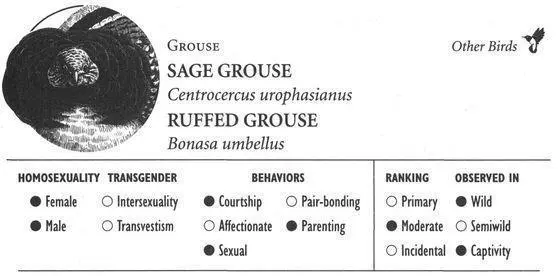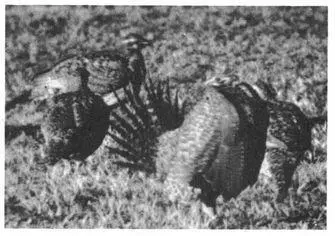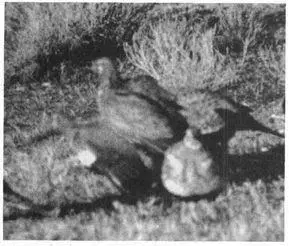Brown, L., and D. Amadon (1968) “ Gyps fulvus , Griffon Vulture.” In Eagles, Hawks, and Falcons of the World , pp. 325–28. New York: McGraw-Hill.
Cramp, S., and K. E. L. Simmons, eds. (1980) “Griffon Vulture ( Gyps fulvus )” and “Kestrel ( Falco tinnunculus ).” In Handbook of the Birds of Europe, the Middle East , and North Africa, vol. 2, pp. 73–81, 289–300. Oxford: Oxford University Press.
*Fleay, D. (1968) Nightwatchmen of Bush and Plain: Australian Owls and Owl-like Birds . Brisbane: Jacaranda Press.
*Heinroth, O., and M. Heinroth (1926) “Der Gansegeier ( Gyps fulvus Habl.) [The Griffon Vulture].” In Die Vögel Mitteleuropas , vol. 2, pp. 66–69. Berlin and Lichterfeld: Bermühler.
*Jones, C. G. (1981) “Abnormal and Maladaptive Behavior in Captive Raptors.” In J. E. Cooper and A. G. Greenwood, eds., Recent Advances in the Study of Raptor Diseases ( Proceedings of the International Symposium on Diseases of Birds of Prey, London, 1980 ), pp. 53–59. West Yorkshire: Chiron Publications.
Korpimaki, E. (1988) “Factors Promoting Polygyny in European Birds of Prey—A Hypothesis.” Oecologia 77:278–85.
Korpimäki, E., K. Lahti, C. A. May, D. T. Parkin, G. B. Powell, P. Tolonen, and J. H. Wetton (1996) “Copulatory Behavior and Paternity Determined by DNA Fingerprinting in Kestrels: Effects of Cyclic Food Abundance.” Animal Behavior 51:945–55.
Mendelssohn, H., and Y. Leshem (1983) “Observations on Reproduction and Growth of Old World Vultures.” In S.R. Wilbur and J. A. Jackson, eds., Vulture Biology and Management, pp. 214–41. Berkeley: University of California Press.
*Mouze, M., and C. Bagnolini (1995) “Le vol en tandem chez le vautour fauve ( Gyps fulvus ) [Tandem Flying in the Griffon Vulture].” Canadian Journal of Zoology 73:2144–53.
*Olsen, K. M. (1985) “Pair of Apparently Adult Male Kestrels.” British Birds 78:452–53.
Packham, C. (1985) “Bigamy by the Kestrel.” British Birds 78:194.
*Pringle, A. (1987) “Birds of Prey at Tierpark Berlin, DDR.” Avicultural Magazine 93:102–6.
Sarrazin, F., C. Bagnolini, J. L. Pinna, and E. Danchin (1996) “Breeding Biology During Establishment of a Reintroduced Griffon Vulture Gyps fulvus Population.” Ibis 138:315–25.
Stanback, M. T., and W. D. Koenig (1992) “Cannibalism in Birds.” In M. A. Elgar and B. J. Crespi, eds., Cannibalism: Ecology and Evolution Among Diverse Taxa, pp. 277–98. Oxford: Oxford University Press.
Terrasse, J. F., M. Terrasse, and Y. Boudoint (1960) “Observations sur la reproduction du vautour fauve, du percnoptère, et du gypaete barbu dans les Basses-Pyrénées [Observations on the Reproduction of the Griffon Vulture, the Egyptian Vulture, and the Bearded Vulture in the Lower Pyrenees].” Alauda 28:241–57.
Village, A. (1990) The Kestrel . London: T. and A. D. Poyser.

SAGE GROUSE
IDENTIFICATION: A gray-brown grouse with speckled plumage, pointed tail feathers, and inflatable air sacs in the breast. DISTRIBUTION: Western North America. HABITAT: Sage grassland, semidesert. STUDY AREAS: Green River Basin and Laramie Plains, Wyoming; Long Valley, California.
RUFFED GROUSE
IDENTIFICATION: A large grouse with a banded, fan-shaped tail and distinctive black ruffs on the side of the neck. DISTRIBUTION: Northern and central North America. HABITAT: Forest. STUDY AREA: In captivity in Ithaca, New York.
Social Organization
During the breeding season, male Ruffed and Sage Grouse display on territories—large, communal “strutting grounds” or LEKS in Sage Grouse, and individual “drumming logs” in Ruffed Grouse. Both species have a promiscuous mating system, in which birds mate with multiple partners, do not form pair-bonds, and females care for the young with no male assistance. Outside of the mating season, birds sometimes congregate in mixed-sex flocks.
Description
Behavioral Expression: At dawn on their prairie display grounds, female Sage Grouse gather in groups of eight to ten (or sometimes more) known as CLUSTERS. Although many are there to mate with males, some females also court and mate with each other. Homosexual courtship display is similar to that used by males and is called STRUTTING. The female takes short steps forward and turns while presenting herself in a spectacular posture—long tail feathers fanned in a circle, air sacs in the breast expanded, and neck feathers erected and rustling. Unlike males, however, strutting females do not make the characteristic “plopping” sound during courtship, owing to the smaller size of their air sacs. When the female has finished her strut, another female may solicit a copulation from her by crouching down, arching her wings and fanning the wing feathers on the ground. The other female mounts her and often performs a complete mating sequence, spreading her wings on either side of the mounted female for balance, treading on her back with her feet, and lowering and rotating the tail for cloacal (genital) contact. Some females also chase others in the group and try to mount them, and “pile-ups” of three or four females all mounted on each other sometimes develop. During most lesbian matings, males pay no attention to the females. Sometimes, however, they try to disrupt a lesbian mounting, or they may even try to join in by mounting a female who is herself mounted on another female. In one case, a male even mounted another male who was himself mounted on two females that were mounting each other! Later in the breeding season, two females also sometimes jointly parent their offspring, combining all their chicks into a single brood that they both look after.
Homosexual courtship in Sage Grouse: a female performing the “strutting” display on the plains of Wyoming

Male Ruffed Grouse also court and mount each other. Deep in the forest, each male advertises his presence by DRUMMING at dawn or dusk, producing a throbbing, drumroll-like sound by rapidly “beating” the air with his wings. If another Grouse lands on the drumming log, he begins his strutting display. Fanning his tail like a turkey, he lowers his wings, erects his neck ruffs, and rotates his head vigorously, all the while emitting a hissing sound as he approaches the other bird. If the other bird is a female, mating takes place, whereas if it is another male, typically a fight will ensue. However, in some cases the other male does not challenge the displaying male. The courting male then makes a “gentle” approach, sleeking down his feathers, dragging his tail on the ground, and occasionally shaking his head. He sometimes pecks softly at the base of the other male’s bill or places his foot on the other’s back and may mount him as in heterosexual copulation (although the mounted bird does not usually adopt the female’s typical copulatory posture).
Homosexual group copulation in Sage Grouse: a female crouching with outstretched wings ( left ) is being mounted by another female ( center, upright bird ), who is simultaneously being mounted by a third female ( right, with its neck extended over the back of the second female ). A fourth female ( foreground, facing front ), is not part of this “pile-up.”

Frequency: Approximately 2-3 percent of Sage Grouse females participate in homosexual courtships and copulations, which occur in perhaps one out of five female visits to the lek (on average); the prevalence of homosexual behavior in wild Ruffed Grouse is not known.
Читать дальше















